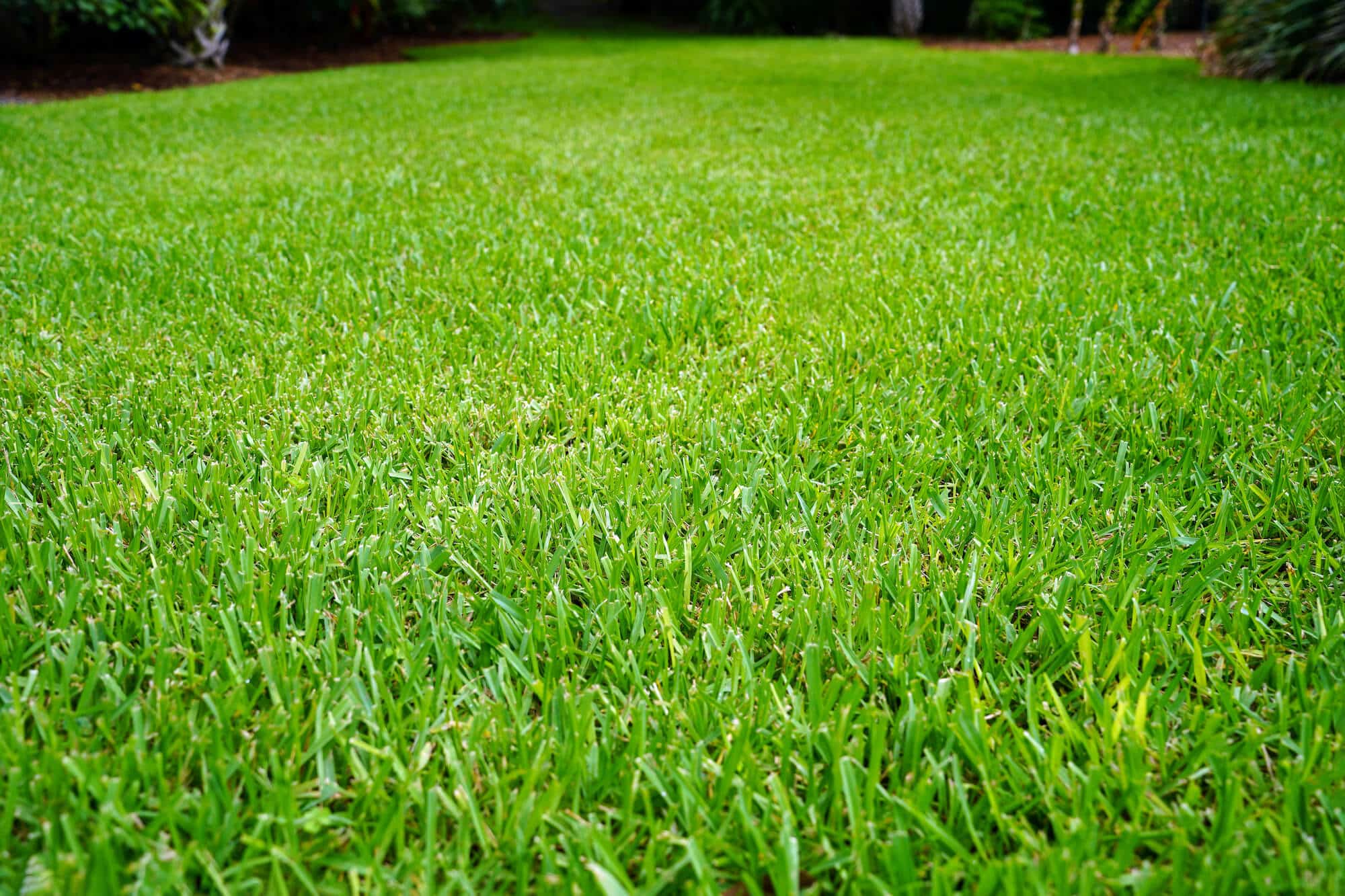St. Augustine Grass
There are plenty of choices when it comes to grass for your lawn, but it can be a lot like fitting the pieces into a puzzle to find a perfect match.
The success of your lawn can depend on factors like drought tolerance, shade tolerance, maintenance requirements, and climate.
Read on to learn more about St. Augustine Grass to sit if it’s a good fit for your grass needs.

Some Facts About St. Augustine Grass
St. Augustine Grass is most commonly found in yards all around the Gulf Coast in the United States.
You can find this type of grass stretching all the way from the Carolinas to Florida, along the Gulf Coast into Texas, and in Southern and Central California.
It does well in tropical regions with sandy beach ridges and also in places with swamps or lagoons, limestone shorelines, and salt or fresh water marshes. t can also be found in some parts of Mexico, Australia, and Africa.
Over time, St. Augustine Grass has crept more inland in places that are more open as well. This grass is actually native to Western Africa, the West Indies, and the Gulf of Mexico region.
- St. Augustine has other names as well. It’s called “Carpet Grass” in California as well as in the Southeastern region of the United States.
- In Argentina, it is referred to as “Gramillion”
- In Australia and the South Pacific, it is labeled “Buffalo Grass”
- In the West Indies and Bermuda, it’s called “Crabgrass”
- In St. Helena, it’s called “Wire Grass” lence
Characteristics & Traits
This type of grass does well with a variety of soil types except anything that is waterlogged or is prone to drought conditions.Ideally, though, St. Augustine Grass does best with moist and fairly fertile soils.
soon field
It’s also more successful in warmer temperatures. In fact, this choice of grass does not handle cold weather well at all, so it is better suited for areas that do not get many cold winter days.
St. Augustine cannot make it very far inland, where it’s dry, without irrigation. This is why the grass’s own migration inland has been restricted to areas that border coastal zones.
While this makes it sound a bit like Bermuda Grass, keep in mind that St. Augustine Grass does not have rhizomes. The stolons, or stems, along with the overlapping leaf sheaths are usually compressed.
The actual leaf blades are folded, rounded at the tip, and contracted at the base.
St. Augustine is a robust perennial grass, which makes it ideal for pastures and yards. It is a coarse textured grass.
St. Augustine is also fairly shade tolerant. In situations where there is heavy shading, though, this type of grass usually only develops into thinner and spindly turf. Fertility and drainage, as well as higher temperatures, are ideal for having a successful section of St. Augustine Grass.
The best pH range for this type of grass is 5.0 – 8.5. Keep in mind, though, that at over about a pH of 7.5, this grass is more prone to develop a chlorotic appearance.
It is not tolerant of waterlogged or compacted soil, but it is highly tolerant of soil salinity.
When comparing to other warm season species of grasses, St. Augustine Grass does not handle high traffic well. This makes it suitable for a yard, but not for anything like an athletic field.
It also does well against weeds and other grasses and is only threatened by a few of the more serious pests.
If the climate is drier with 30 inches or less of annual rainfall, it can still survive and provide good grass with proper irrigation. If more maintenance is invested, the lawn can maintain a dark green, thick, and lush appearance.
Where Did It Come From & What Are The Varieties?
Before 1800, St. Augustine Grass was documented in the West Indies, Brazil, Bermuda, Uruguay, Sierra Leone, Nigeria, and South Carolina.
It was also reported in Kauai before 1800. And by 1840, there were reports of this type of grass in New Zealand and Australia.
Some of St. Augustine’s varieties include:
Floratine
This type of St. Augustine Grass was the result of the Florida Agricultural Experiment Station and was released in 1959. There are several features of this grass that differ from the original. For one thing, it has a finer texture, and it is a deeper shade of green. This strain also tends to keep its rich color later into fall and does better with closer mowing.
Bitter Blue
This strain of St. Augustine Grass was around prior to Floratine and became the preferred variety for yards until Floratine was created.
Raleigh
Also introduced in 1980, this strain was released by the North Carolina Experiment Station. The difference is this variety was meant to be a cold tolerant strain that was also resistant to SAD. It is finer than Floratam and develops into a denser turf. This strain is also does better in shade, but lacks the tolerance to chinch bugs.
Texas Common
This type has been produced commercially in Texas since 1920.
Seville
Seville was created as an attempt to resist SAD and tolerate chinch bugs. It was released by the O.M. Scott and Sons Company in 1980. It is finer in texture and cannot tolerate colder weather.
Floratam
In 1972, this variety was released by the Florida and Texas Agricultural Experiment Stations. This strand was also created to not be as susceptible to chinch bugs and the SAD virus. The leaf blades of this strain are wider than traditional St. Augustine Grass. This type of grass is most commonly used in South Florida for pasture grass, mostly on muck soils. Floratam is also not as resilient against cold as the type that is found in Texas, so it’s best for areas in Southern Florida and other coastal zones in the South. However, Floratam does not have the shade tolerance that some of the other choices for St. Augustine Grass do.
Advantages & Disadvantages
Every grass type has pros and cons. Some of how you view them just depends on where you live. For example, one grass may not do well at all in cold weather, like St. Augustine Grass. However, if you live in Florida, this isn’t a concern for you.
Here are some quick notes on what makes St. Augustine Grass great and what its setbacks are.
Advantages
- Does well with soil salinity and high elevations.
- It requires only moderate levels of maintenance.
- It competes well against weeds and other grasses.
- There are just a few serious pests that pose a threat to St. Augustine Grass.
- There is not much mowing required.
Disadvantages
- St. Augustine Grass is not tolerant of cold weather.
- It is also not drought tolerant and, for dry inland areas, would require supplemental irrigation.
- It does not handle higher traffic as well as some of the other choices for warm season grasses.
- St. Augustine Grass needs fertilization for the first three months of establishment.
Establishment & Maintenance
St. Augustine can be established using sod, plugs, or stolons. Seeding is not a good option for starting your lawn as of now. Sod is ideal, but using stolons helps it spread very rapidly.
You will need to fertilize during the establishment period, which is typically the first three months.
Watering, Moving & Pest Management
The continued success of your St. Augustine lawn depends on its proper management. So for anyone who wants a more maintenance-free lawn, this is not the ideal match.
However, if you are situated in a coastal area that gets plenty of rainfall (but not too much or with adequate drainage), you will not need to invest as much care.
Regular mowing slows to just twice a month during late fall and into early winter. Iron deficiencies are a common problem with this type of grass. Potassium has been proven to increase the growth of roots and help with both the drought and cold tolerance for St. Augustine Grass.
There are several pests that threaten St. Augustine Grass, but the most common is the chinch bug. The problem is that in warm climates like Florida, these bugs are active all year long and pose a big threat. Pests that can harm St. Augustine Grass in other areas include white grub, SAD, and brown patch.
Problems with any of these mean you will need to invest more effort and money into the management of your yard. This is something to seriously consider when it comes to choosing which grass is best for you.
If proper fertility, drainage, warm temperatures, and moderate maintenance are things your environment can offer, then St. Augustine Grass could be a great option for you.







